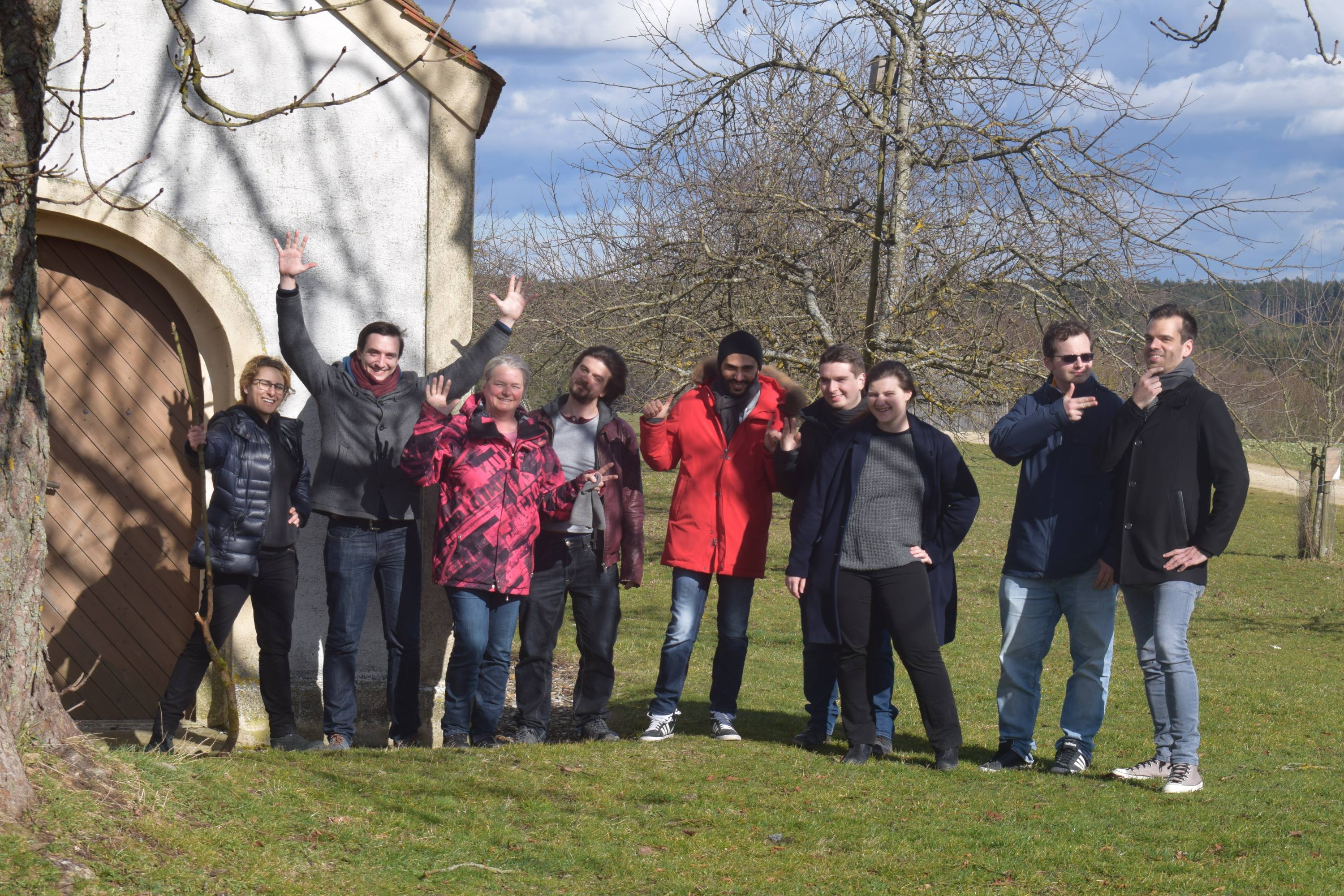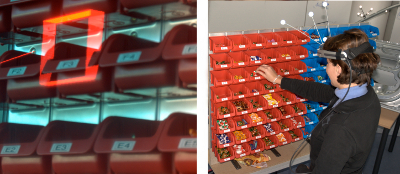Forschungsgruppe Augmented Reality (FAR)
Prof. Gudrun Klinker, Ph.D. Augmented Reality (AR) is a newly emerging technology by which a user's view of the real world is augmented with additional information from a computer model. With AR, users can access information without having to leave their work place. They can manipulate and examine real objects and simultaneously receive additional information about them or the task at hand. Using AR technology, the information is presented three-dimensionally integrated into the real world. Exploiting people's visual and spatial skills to navigate in a three-dimensional world, Augmented Reality thus constitutes a particularly promising new user interface paradigm. Read more... Check out our channel on youtube AugmentedRealityTUM.People

Photo: Hitzhofen, Mar. 2019 (Not all members are in the pic:))
- Scientific Staff: Chloé Eghtebas, Christian Eichhorn, Adnane Jadid, Andreas Langbein, Sven Liedtke, Dr. Frieder Pankratz, Dr. David Plecher, Linda Rudolph, Sandro Weber.
- Administrator: Manfred Röslmair
- External Ph.D. students: Fabrizio Palmas (straightlabs), Florian Raith (Hochschule München), Kevin Thiel (Volkswagen AG), Christian Waechter (SEMCON), Christian Wiesner (Bosch).
- Visitors: Dr. Marijn Stollenga
- Alumni and Collaborators: list
Research Issues
Our research focus lies on bringing AR technology into real applications. To this end, we look not only at "classical AR" solutions but consider suitable variations, thereby combining AR with concepts of mobile and ubiquitous computing. This leads to the concept of Ubiquitous Augmented Reality (UAR). We investigate (not necessarily disjunct) issues with respect to:- Sensing:
To track users and mobile objects in the real world, suitable sensors need to be registered, calibrated and combined in real-time (i.e.: at video rate). We use, test, evaluate and enhance sensing technology, placing particular emphasis on the establishment of sound characteristics of measurement noise.
- Ubiquitous Tracking (Sensor Fusion):
AR-based tracking strives for high presicion and speed. Location-based tracking support focuses on generality, flexibility, wide range of use, and low cost. We work towards a framework for sensor fusion, that allows for flexible, dynamically configurable combinations of several trackers, using location-based approaches to generalize and backup more brittle and constrained high quality tracking technology.
- 3D Information Presentation:
AR presents computer-based information three-dimensionally embedded into the real surroundings of a user. Visualizations can be shown on head-mounted displays (HMDs), mobile monitors (tablet PCs, PDAs, mobile phones, or intelligent instruments), nearby stationary monitors (desktops, walls), or as direct projections onto real objects. We conceive, investigate and compare such presentation techniques, as well as flexible, context-dependent combinations thereof. - 3D Interaction:
When computer-based information is embedded within the real environment of users, users can react to such information directly within such real-world context - by manipulating real objects in addition to gesturing, speech, 3D pointing, and "standard" human-computer interaction via so-called "WIMP" (desktop-based) user interfaces. We investigate suitable combinations of such interfaces - with particular emphasis on direct 3D human-computer interaction embedded in the real world (tangible UIs). - HCI in Cars:
User centered driver assistance with minimalistic interactions for active safety. The focus relies on embedded Augmented Reality and its use for the assistance part of all in-vehicle information systems. To improve driving performance, the driver is intended to reside in the control circuit of the driving task instead of being taken out for gathering information from secondary sources as warning or navigation systems and displays. - Multitouch Displays:
Recently, interaction devices based on natural gestures have become more and more widespread, e.g. with Jeff Han's work (watch on YouTube), Microsoft Surface or the Apple iPhone. These devices particularly support multi-touch interaction, thereby enabling a single user to work with both hands or even several users in parallel. In this project, we explore the applications of multi-touch surfaces, both large and small. We are building and evaluating new hardware concepts as well as developing software to take advantage of the new interaction modalities.
- System Architectures for Ubiquitous Augmented Reality:
In order to provide ubiquitous tracking, information presentation and interaction facilities, the underlying system architecture needs to be very flexible, adaptive and extensible. We have built an ad-hoc, peer-to-peer framework. We are evaluating and extending and/or simplifying the system. We are also exploring how to base the system on concepts and tools to specify, customize and analyze desired system behavior.
- Industrial Augmented Reality:
We actively pursue intense relationships with industry partners who provide us with information pertaining to the real-world requirements and trade-offs of transferring AR technology into real applications.
Projects
Find all FAR Research ProjectsOpen Theses
Find all Open ThesesPublications
Read our full FAR Publication List.Habilitation
- Jun. Prof. Dr. Oliver Bimber (external from Bauhaus Universität, Weimar): Projector-Based Illumination and Display Techniques (March 2007)
Dissertations
- David A. Plecher: Impacts of Serious Games for Cultural Heritage (May 2021)
- Axel Jansen: Augmented Reality in der Fahrzeugnavigation (März 2018)
- Sebastian Knorr: Leveraging the User's Face as a Known Object for Reconstructing the Real World in Augmented Reality (Jan 2017)
- Andreas Dippon: Natural Interaction in Multi-Device Environments (Oct 2016)
- Christoph Resch: Enhancing Projective Spatial Augmented Reality in Industry (Jun 2016)
- Gel Han: Development of an Indoor Location Tracking System for the Operating Room (May 2016)
- Yuta Itoh: Calibration and Use of Optical See-Through Head-Mounted Displays towards Indistinguishable Augmented Reality (Mar 2016)
- Frieder Pankratz: Augmented Reality for Augmented Reality (Jan 2016)
- Markus Duschl: Critical Assessment of Data Visualization from the Electronic Horizon in the Context of a Deceleration Assistance System (Nov 2015)
- Tayfur Coskun: Two-Handed User Interfaces for Mobile Devices (Oct 2014)
- Daniel Kurz: Sensor-Aided Visual Camera Localization and Tracking for Handheld Augmented Reality (Sep 2014)
- Patrick Maier: Augmented Chemical Reactions - Research on 3D Selection and Confirmation Methods (Sep 2014)
- Christina Simon (Gackstatter): Straßenumfeldmodellierung durch Fusion und Interpretation von Sensordaten zur spurgenauen Positionierung des Fahrzeugs (May 2012)
- Torsten Seyffarth: Bildbasierte Abstandsregelung für Kraftfahrzeuge (Apr 2012)
- Alexander Neumann: Simulationsbasierte Messtechnik zur Prüfung von Head-Up Displays (Feb 2012)
- Michael Schlegel: Zeitkalibrierung in Augmented Reality Anwendungen (Dec 2011)
- Manuel Huber: Parasitic Tracking for Ubiquitous Augmented Reality (Nov 2011)
- Peter Keitler: Management of Tracking and Tracking Accuracy in Industrial Augmented Reality Environments (Apr 2011)
- Simon Nestler: Konzeption, Implementierung und Evaluierung von Benutzerschnittstellen für lebensbedrohliche, zeitkritische und instabile Situationen (Jul 2010)
- Björn Schwerdtfeger: Pick-by-Vision: Bringing HMD-based Augmented Reality into the Warehouse (Jul 2010)
- Stephan Thoma: Mensch-Maschine-Interaktionskonzepte für Fahrerassistenzsysteme im Kreuzungsbereich (Apr 2010)
- Florian Echtler: Tangible Information Displays (Dec 2009)
- Rudi Lindl: Tracking von Verkehrsteilnehmern im Kontext von Multisensorsystemen (Apr 2009)
- Katharina Pentenrieder: Augmented Reality based Factory Planning (Feb 2009)
- Marcus Tönnis: Towards Automotive Augmented Reality (Nov 2008)
- Leonhard Walchshäusl: Maschinelle Erkennung von Verkehrsteilnehmern mittels heterogener Sensorik (Oct 2008)
- Verena Broy: Benutzerzentrierte, graphische Interaktionsmetaphern für Fahrerinformationssysteme (Nov 2007)
- Martin Bauer: Tracking Errors in Augmented Reality (Sep 2007)
- Hesam Najafi: Fast 3D Object Detection and Pose Estimation for Augmented Reality Systems (Dec 2006)
- Stefan Nölle: Augmented Reality als Vergleichswerkzeug am Beispiel der Automobilindustrie (Nov 2006)
- Christian Sandor: A Software Toolkit and Authoring Tools for User Interfaces in Ubiquitous Augmented Reality (Oct 2005)
- Asa MacWilliams: A Decentralized Adaptive Architecture for Ubiquitous Augmented Reality Systems (with Prof. Brügge) (Jun 2005)
- Martin Wagner: Tracking with Multiple Sensors (Apr 2005)
- Thomas Reicher: A Framework for Dynamically Adaptable Augmented Reality Systems (with Prof. Brügge) (Apr 2004)

